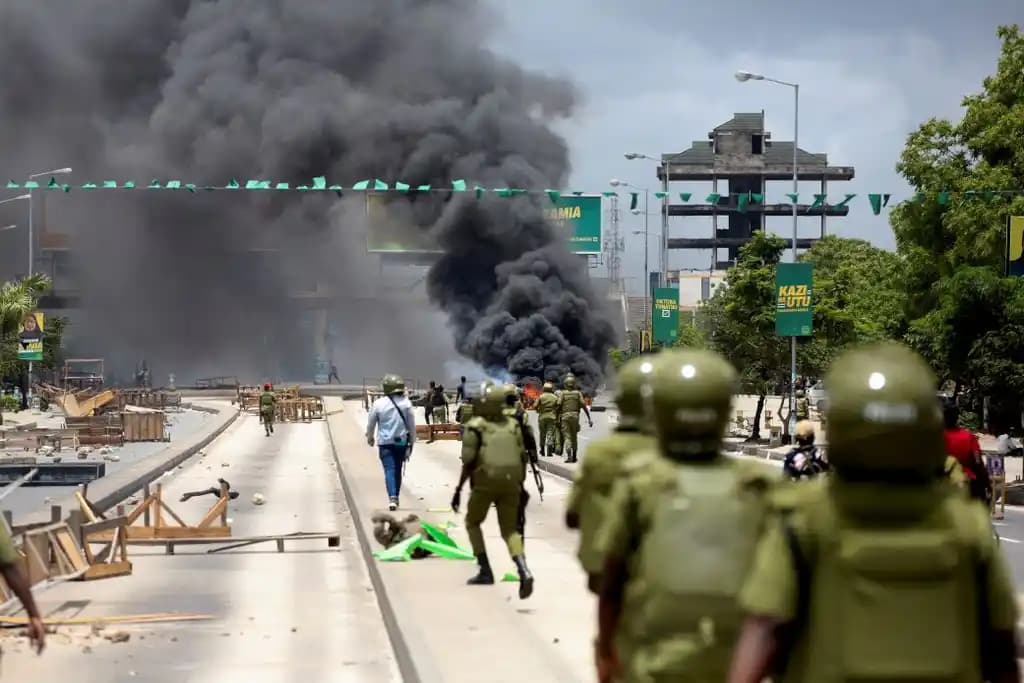We're loading the full news article for you. This includes the article content, images, author information, and related articles.
Violent post-election protests in Tanzania have spilled over to the Kenya-Tanzania border, resulting in fatalities and paralysing trade, raising urgent regional stability concerns for Nairobi.

Tanzania is grappling with a severe political crisis following its general election on Wednesday, October 29, 2025, which has been marred by widespread protests, deadly violence, and a near-total internet blackout. [4, 6] Demonstrations erupted in major cities, including Dar es Salaam and Arusha, as citizens protested what many observers have labelled a sham election. [4, 28] The government of President Samia Suluhu Hassan, who was widely expected to win after major opposition parties were barred from contesting, has responded with a heavy security crackdown, including deploying the military and imposing curfews. [5, 6] Amid the turmoil, the whereabouts of President Suluhu and senior government officials have been widely questioned, though these reports remain unconfirmed by official sources as of Friday, October 31, 2025. [22, 24, 30]
The instability took on a direct dimension for Kenya on Thursday, October 30, when protests turned deadly at the Namanga One-Stop Border Post. [7] Two Tanzanian nationals were shot and killed by Tanzanian police officers who fired across the border at protesters who had gathered on the Kenyan side. [18] Kajiado County Police Commander Alex Shikondi confirmed the fatalities, stating the men, aged 27 and 28, were hit by bullets fired by the Tanzania Police Force (TPF). [18] The clashes paralysed the crucial trade and travel artery for hours, with protesters lighting bonfires and destroying campaign billboards featuring President Suluhu. [7, 15] Kenyan law enforcement officers were deployed to prevent Kenyan youths from crossing into Tanzania to join the demonstrations. [7, 12] The internet shutdown on the Tanzanian side has also severely hampered customs and cargo clearance, causing significant economic disruption. [15]
The election on Wednesday was held in a climate of intense repression, according to international rights groups. [26, 29] The main opposition party, CHADEMA, and its leader Tundu Lissu were barred from participating. [26, 29] Lissu is currently detained on treason charges. [26] This effectively removed any significant challenge to President Suluhu and the ruling Chama Cha Mapinduzi (CCM) party, which has been in power since 1961. [5, 26] In response to the growing unrest on election day, Tanzanian authorities implemented a nationwide internet disruption, which was confirmed by internet observatory NetBlocks. [8, 9] The blackout has created an information vacuum, making it difficult to verify reports of casualties and the full extent of the violence. [8] Amnesty International has reported documenting at least two deaths from the protests in Dar es Salaam on Wednesday, separate from the Namanga fatalities. [5, 17]
The escalating crisis has drawn sharp criticism from international bodies. The European Parliament issued a statement declaring the elections were “neither free nor fair,” citing the climate of fear and the exclusion of the opposition. [25] Regional human rights organizations, including the Kenya Human Rights Network, condemned the violations, stating the events “go against the very principles that underpin the East African Community.” [4, 21] Observer missions from the African Union (AU) and the Southern African Development Community (SADC) were present for the election but have yet to release their substantive preliminary findings amid the chaos. [16, 19, 28] The silence of regional bodies has been criticised by some civil society groups as enabling the democratic backslide in the country. [23] The Kenyan government has urged calm, with officials in Kajiado asking residents to avoid involvement in the neighbouring country's internal affairs. [7]
The unfolding situation presents a significant challenge for Kenya and the broader East African region. The violence at the Namanga border highlights the immediate security risks and the potential for cross-border spillover. Protracted instability in Tanzania, a key trading partner and fellow EAC member, could disrupt regional supply chains, impact tourism, and create a refugee crisis. Nairobi faces a delicate diplomatic balancing act between upholding the EAC's democratic principles and maintaining a stable relationship with the Tanzanian government. The crisis serves as a stark reminder of the fragility of democratic processes in the region and the potential for electoral disputes to escalate into wider security and economic emergencies. [31] Further investigation is required to confirm the status of Tanzania's leadership and the full scale of the casualties.
Keep the conversation in one place—threads here stay linked to the story and in the forums.
Other hot threads
E-sports and Gaming Community in Kenya
Active 7 months ago
Popular Recreational Activities Across Counties
Active 7 months ago
The Role of Technology in Modern Agriculture (AgriTech)
Active 7 months ago
Investing in Youth Sports Development Programs
Active 7 months ago